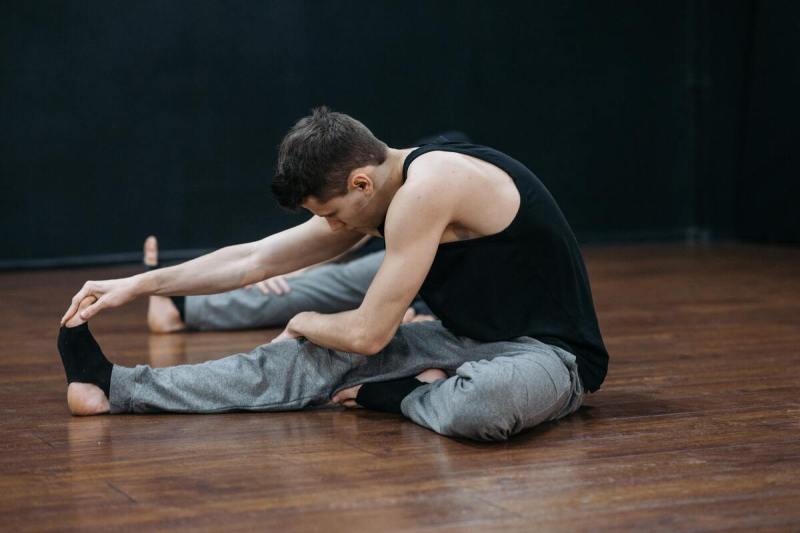After turning 40, you’ll notice your body changing. You adjust specific routines, maybe add eyewear that helps improve vision or knee wraps during a run to avoid aches. Aging is a process, and exercising regularly can help you do it gracefully. Strengthening bodyweight exercises are especially important as you get into your forties and beyond.
Doctors, physical therapists, or coaches will tell you the idea that “it’s all downward spirals when exercising in middle age” is outdated. However, when your body changes, it’s a good idea to pay attention.
For example, testosterone levels may decrease along with tendon and ligament vascularity. You might also need more recovery time after challenging workouts.
Fight the urge to make huge, dramatic shifts in your exercise routine. Instead, make smaller changes, such as fixing mistakes or overcoming bad habits. Check out these common bodyweight workout errors to avoid.

You don’t work on your flexibility and mobility
As we get older, it’s easy to forget the importance of exercise. We juggle family and work responsibilities, and exercising doesn’t always fit seamlessly into our schedule. During middle age, staying physically fit becomes even more important. Therefore, we have to get up off the couch and work out, even when we don’t want to.
After all, a sedentary lifestyle will hurt you in a variety of ways. Not only will you put yourself at risk for obesity, diabetes, and heart disease, but your joints will also lose their ability to move through a full range of motion. This will cause you to lose flexibility, something you need for even the most routine of daily activities.
Losing flexibility also increases your risk of everyday injury, limits circulation, and negatively affects your standing and sitting postures. Protect your muscles, tendons, and ligaments. Avoid unnecessary surgeries.
Add regenerative exercises like yoga and pilates to your routine so that you’ll maintain flexibility and mobility as you age.

You skip your warm-up and cool-down routines
Getting in shape at 40 means you must warm up before working out and cool down afterward. This is vital, especially as we age, to avoid potential injuries. If you don’t take the time for this basic self-care, you could lose time to bed rest and muscle loss. It’s not worth it.
Warming up and cooling down don’t have to be time-consuming activities. A few stretches or jumping rope will loosen and warm your muscles. This gets them ready for lifting so your stabilizers and connective tissues work more effectively. Light warm-up sets also sync up your mind-muscle connection to make the most of each movement.
Cooling down after a workout removes lactic acid from your body and slowly regulates your heart rate. Again, this doesn’t have to take a lot of time. Incorporating simple stretches, covering important muscles, or a 6 to 7-minute yoga flow could give you the cooldown you need before getting on with your day.

You take it too easy
It’s common to get into your forties and forget to put some intensity into workouts. Don’t fall into the trap of a mundane, ho-hum exercise routine. You may feel the urge to stick with what you know or do the bare minimum. But never challenging yourself comes with a price.
Sticking with the old routine of two to four sets of six to ten reps while placing too much focus on elements like time under tension can lead to muscle deterioration. Don’t miss out on the benefits of one important essential: power training. Add simple exercises like kettlebell swings into your regimen. Include other adjustments, like using more force with bench presses and squats.

You aren’t consistent
You won’t see improvements or other positive results if you’re not consistent. Think about when you were a bit younger and just starting. You trained with consistent effort and energy. Week after week, you showed up for yourself. And you noticed results.
When you start to miss a workout here or there, you might not think it’s a big deal. You’ll just catch up when you get back at it. But when you reduce your intensity or stop altogether, it gets harder to return to that energy. This is especially true if you’re eating and drinking as if you’re working out when you’ve stopped.
Unfortunately, one lousy week can easily turn into a lousy month. If you don’t hold yourself accountable, it can be difficult to get back to where you used to be. Inconsistencies with the training lead to inconsistencies with nutrition and other areas of life. This is how people lose their way and begin to gain weight and lose muscle in middle age.
You can’t always control external issues and may need to miss a workout. However, you can create alternative plans to minimize the chances of an interruption and, therefore, the effect of it.
Plan social events and workouts so that you can have both without jeopardizing the gains you’ve made in your fitness level.

You don’t use modifications
The kinds of workouts that made sense in your 20s won’t make sense anymore in your 40s. If you do try to hold on to one-rep maxes or rounds in the right, you may risk walking away with soreness and injuries. Sometimes you won’t be able to walk away at all.
Instead of clinging to what no longer serves you, use modifications that involve medium-weight, medium-rep exercises. Even better? Incorporate routines with a large range of motion. Such modifications include using the following:
- Kettlebells
- Yoga
- Swimming
- Martial arts
- Barbell exercises
Unfortunately, too many people over 40 skip certain exercises altogether because they think it’s too difficult for their age group. A better choice would be to use modifications that maximize the results and produce exactly the kind of strength and flexibility your older body needs.

You don’t balance your aerobic and anaerobic exercises
When you neglect the cardio and conditioning portion of your workouts, you’ll lose steam pretty fast. You want to increase your longevity, not deplete it. Since metabolism begins slowing down after age 40, you must burn calories in other ways. Discover exercises and routines that elevate your heart rate.
Start slow. Find a way to include up to ten minutes of aerobic activity every day. Include these short but sweet bursts into strength training toward the end of the workout. Do this by jumping on the treadmill or row machine.
Push yourself a little bit more by adding less than a minute of interval training. A long run, ride, or swim will also add important cardio to your workout. Keep it steady and consistent on a weekly basis.



